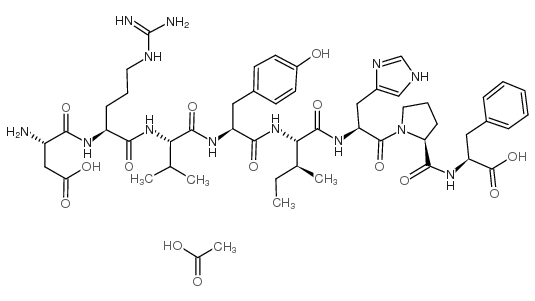68521-88-0
| Name | Angiotensin II |
|---|---|
| Synonyms |
ANGIOTENSIN II ACETATE HUMAN
ANGIOTENSIN II HUMAN ACETATE SALT EINECS 206-182-3 Human angiotensin II acetate salt ANGIOTENSIN,HUMAN angiotensin ii human acetate ANGIOTENSIN II ACETATE SALT ANGIOTENSIN II,MASS SPEC STANDARD HYPERTENSIN II ANGIOTENSIN II,HUMAN,SYNTHETIC Angiotensin II human |
| Description | Angiotensin II human acetate (Angiotensin II acetate) is a vasoconstrictor that mainly acts on the AT1 receptor. Angiotensin II human acetate stimulates sympathetic nervous stimulation, increases aldosterone biosynthesis and renal actions. Angiotensin II human acetate induces growth of vascular smooth muscle cells, increases collagen type I and III synthesis in fibroblasts, leading to thickening of the vascular wall and myocardium, and fibrosis. Angiotensin II human acetate also induces apoptosis[1][2]. |
|---|---|
| Related Catalog | |
| In Vitro | Most of the known actions of Angiotensin II (Ang II) are mediated by AT1 receptors, the AT2 receptor contributes to the regulation of blood pressure and renal function[1]. Angiotensin II raises blood pressure (BP) by a number of actions, the most important ones being vasoconstriction, sympathetic nervous stimulation, increased aldosterone biosynthesis and renal actions. Other Angiotensin II actions include induction of growth, cell migration, and mitosis of vascular smooth muscle cells, increased synthesis of collagen type I and III in fibroblasts, leading to thickening of the vascular wall and myocardium, and fibrosis. These actions are mediated by type 1 Ang II receptors (AT1)[2]. At the cellular level, responsiveness to Angiotensin II is conferred by the expression of the two classes of angiotensin receptors (AT1 and AT2). The effects of Angiotensin II to increase blood pressure are mediated by AT1 receptors[3]. |
| In Vivo | To distinguish the AT1 receptor population that is critical for the pathogenesis of hypertension, osmotic minipumps are implanted s.c. into each animal to infuse Angiotensin II (1,000 ng/kg/min) continuously for 4 weeks. Angiotensin II causes hypertension by activating AT1 receptors in the kidney promoting sodium reabsorption[3]. |
| References |
| Molecular Formula | C52H75N13O14 |
|---|---|
| Molecular Weight | 1106.23000 |
| Exact Mass | 1105.56000 |
| PSA | 443.64000 |
| LogP | 3.16040 |
| Appearance | powder | orange |
| Storage condition | −20°C |
| Water Solubility | H2O: 25 mg/mL, clear, colorless |
| Hazard Codes | Xi |
|---|---|
| WGK Germany | 3 |
